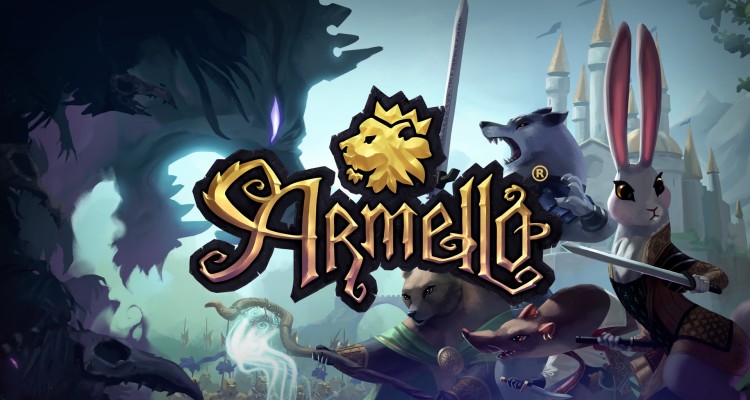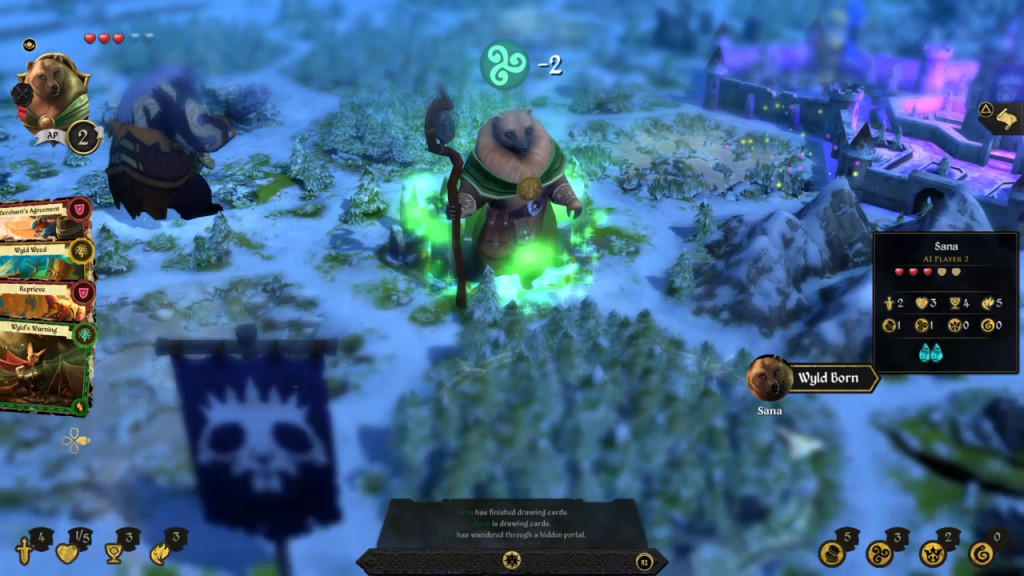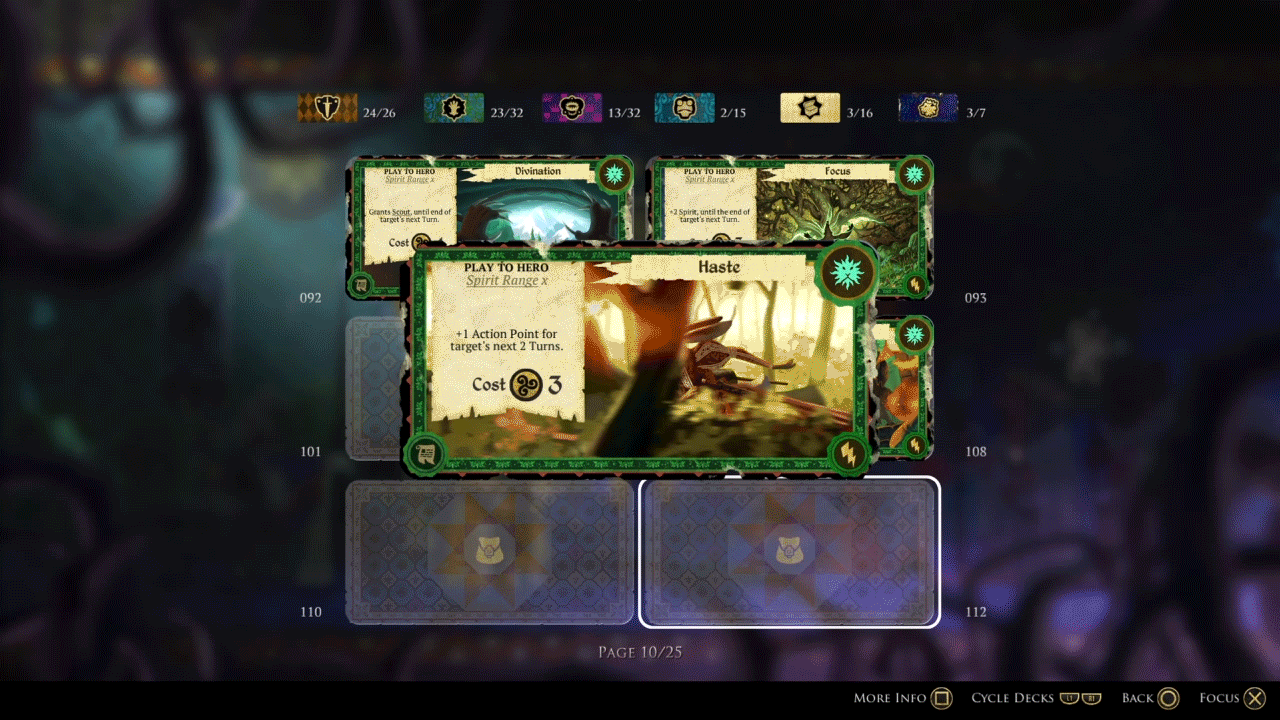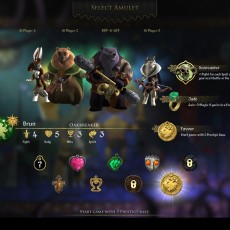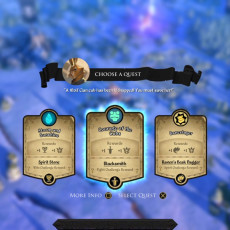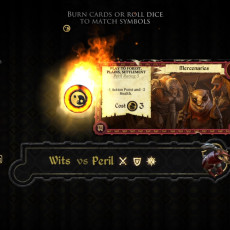Armello, developed by the independent game collective League of Geeks, is a digital tabletop board game set in a unique high-fantasy world of anthropomorphic animals. Although Armello technically qualifies as a video game, currently available on PC and Playstation 4, it is largely a digital representation of an adventure-style board game; complete with dice-rolling, card drawing, and a hex-based map. In Armello, you can take the role of eight available characters that each represent one of the four prominent clans of the land. Through a turn-based Action Point system, you will travel across the board and attempt to win control of Armello’s soon-vacant throne in one of four ways:
- By defeating the dying King in a battle of strength
- By gathering four Spirit Stones and attempting to cure the King of his ailment
- By gathering the most Prestige across the land and inheriting the throne upon the King’s death
- By embracing the very darkness that consumes the King and slaying him with its power
Mechanically, whichever victory condition you choose to pursue will be accomplished by completing randomly-generated quests, boosting your four basic character statistics — Fight, Body, Wit, Spirit — and hindering your opponents from getting there first. The strategic choices of the game are completely open; in a very sandbox fashion, you can change your end goal mid-game and react to the board state as it evolves around you.
Quest completion and combat, the two primary means of advancing towards victory, hinge on probability-based systems. For quests, your relevant statistic will provide a percentage chance for completion; for example, a Fight statistic of four will generate a 40% chance of success for Fight-based quests. Quests will also increase the same statistic they’re based on, making completing a series of similar quests progressively easier — aiding in the specialization of your character.
Similarly, combat is directly linked to these character statistics. During a combat action, each character involved will generate a dice pool based on their relevant statistics (typically Fight) and any equipment cards they may have. These dice, featuring six different symbols, will generate different results based on the specific character, equipment in use, and other environmental effects in play, such as whether it is day or night.
The importance of quests and combat in regards to your success means that luck mitigation is a core feature of Armello’s strategic gameplay. Spending time building your character’s abilities is paramount to reaching that end goal, in addition to simply surviving the hazards presented round-to-round. Keep in mind that the King’s death grows ever closer by the day, so time remains a precious commodity in its own right.
Cleanse the Spirit or Rot the Soul?
Looking at its successes, Armello brings a lot to the digital tabletop that board and video gamers likely won’t find in the same place very often; the most obvious being the production value and stunning representation of the world. Armello features an artistic style that is simultaneously endearing and macabre, as animated rabbits, rats, bears and wolves cut each other down for a chance at power. It’s not overdone, though; Armello takes a tone that is more Game of Thrones and less Happy Tree Friends. The subtle animation of the cards, limited but graceful animations of each character model, and general attention to detail throughout the game elevates the experience and makes it easy for you to fall deep within the narrative world.
Armello is coupled with equally engaging gameplay that generally provides opportunities for strategic planning and luck mitigation. Decision-making begins before the board even populates, as players must pick from eight asymmetric characters and choose what starting bonuses will best complement their play style. Further depth emerges as game-changing law cards are chosen by the Prestige leader, while players balance drawing from three different card decks to fill their hand, and must discover where perils — hidden dice based challenges with negative consequences — fall along the path to victory. It is an experience that feels surprisingly familiar to a seasoned board gamer, but offers enough elements that are better suited for a digital platform to feel new and interesting.
Where Armello struggles is in sustaining this engagement for a player who has simply drawn the short straw in the probability game. As mentioned, Armello includes ways to mitigate the luck of combat and quests: you can take “safe options” on quests to take a stat boost without risking the consequences of the random roll; in combat and during perils, you can “burn” cards to automatically succeed at rolling a particular symbol; gathering spirit stones does not require an ability check, meaning this is largely a luckless route to victory. Even with these safeguards and avenues, Armello players still occasionally suffer from the potential to simply get locked out by Lady Luck. It is not necessarily a common outcome, but the threat constantly lingers and a bad roll of the dice at a critical moment can spoil an entire game.
Along these same lines, Armello’s strategic sandbox can be a bit overwhelming at first. The inclusion of a four-part tutorial is fantastic, but do not dare start a local or online match without completing this overview first. The engaging depth of the game is not without a learning curve that will vary based on your experience with tabletop corollaries. Some of the elements and interactions remain ambiguous even after the tutorial, and the in-game Guide still leaves certain relevant explanations out. A trip to Google to completely understand gameplay shouldn’t be a requirement, but here it was.
Final Thoughts
Armello is a surprising production, particularly for the PS4 platform, but one that should be fully embraced. The game succeeds in providing an enjoyable world that is vividly portrayed and allows players to become an immersed participant. Its staying power, though, will be entirely dependent on personal tolerance for learning the inner workings of the systems and having to start up a new game with the bitter taste of a bad dice roll on your palate.
The League of Nonsensical Gamers would like to thank League of Geeks for kindly providing us with two free copies of Armello for this review.
League Ruling
Biff
Blending board and card game mechanics with gorgeous animated art to help bring its heroes and the fantastical world to life, Armello creates a special experience. Vying for the crown of a dying King, there are four paths to victory and strategic choices abound, as your unpredictable opponents and dice rolls lovingly wedge a monkey wrench in your attempt to conquer. For me, battling through perils, banes, guards, opposing heroes and even the King himself (no small feat!) has been a refreshing deviation from the oft-played tabletop games. For anyone familiar with board games, it seems on par with a medium-weight game, averaging about an hour a match. There’s a bit of a learning curve to fully understand how each aspect plays into the overall formula, but there’s a great prologue to guide you as you begin your path to mastery.
Moving your character around the beautifully-rendered hexagonal tiles is intuitive, with the ascension of mountains costing an extra action point and swamps affecting your health as you attempt to traverse the muck. Most interesting of the movement mechanics is the ability to enter stealth mode when entering the cover of trees at night. Doing so removes the character visually from the board allowing for concealed movement and ambushes on your opposition.
Dependent upon your endgame, interaction with other characters can be avoided completely, but, as the game progresses and the landscape evolves, you may not be so lucky and instead fall at the hand of a bear’s American Gladiator-esque pugil stick. Thankfully, a death in Armello isn’t the end of the road. Instead, you’ll return to your clan village sans one Prestige point and hope that umpteen perils haven’t been planted outside your spawn as you reevaluate your game plan.
The battles between characters can be quite satisfying if you’ve carefully calculated your approach and things go in your favor. But, unfortunately, luck will inevitably rear its ugly head at certain points throughout since battles are determined by dice. The card play aids in alleviating some of the luck of dice battles and perils, with equippable cards and followers for bonuses along with the ability to burn cards for symbols to get a leg up, but you’ll likely have to roll and hold onto your butt. That, of course, is the nature of dice. Whether or not you can condone it, as Matt stated, will likely influence your enjoyment of the game.
At the moment, the victory conditions don’t seem particularly balanced, but it’s great to have choices even if some of them seem farfetched in comparison to the most prevalent, the Prestige Victory. Even with the AI, whose difficulty can not be tweaked, generally glossing over the Spirit Stones (collect four to attempt to cure the King), I still found it difficult to obtain them in time as their spawns are random.
One last thing I’d like to mention is the camera angles, or lack thereof. Pulling back positions the camera in a very atmospheric, but obtrusive bird’s eye view, putting your head, literally, in the clouds. Conversely, zooming in creates a tilt-shift effect with a sliver of focus onscreen. These, along with no camera rotation, seem to be questionable from a design standpoint as neither of these angles are feasible for actual gameplay, so expect to have a limited view.
Those caveats aside, I’m still enjoying my time with Armello. It provides an extremely polished experience, like no other in the digital board game realm, and the unique blend of familiar tabletop mechanics work well, even if dice unveiling your fate from time to time is unfavorable. With a few small tweaks—more balanced victory conditions, AI difficulties and those damn clouds!—I think Armello could be fantastic. But, for now, I have a love/hate relationship with it.
Matt
Between Biff’s Ruling and our aggregated thoughts in the main review, I think it’s safe to say that Armello is a game that is generally a welcome addition to our game libraries. It offers a fresh look at the intersection of board and video games, with gameplay that is rewarding, particularly across multiple plays. In its current state, experimentation will likely be met with failure—as Biff pointed out, the Prestige victory is simply a dominant strategy—but that isn’t necessarily a bad aspect of the game. The digital format compresses the time that would be needed to play an analog corollary, enabling riskier plays for the sake of exploring the game system. Minor quibbles like the limited camera angle, small in-game text and lack of in-game voice chat do beg the question, “Why?” without providing much of an answer for any of these restrictions. These elements, however, do not completely spoil the experience and are things that could be fixed with a future update.
In the moment, Armello remains an interesting offering, particularly for the PS4 platform, which lacks a breadth of games with similar strategic depth. Its longevity, though, will depend wholly on the developer’s choices in the short-term regarding expanding the gameplay, new content, and shoring up some of the weak spots in an otherwise enjoyable title.
Smee’s Two Pence
Armello is an adventure game, and they and I don’t always see eye to eye on certain subjects. Still, the nature of an animated world such as this brought me in close enough to take a look and see how all of the pieces are put together.
The first thing that I noticed during my introductory games is that life is cheap in this peril-fraught kingdom. Expect to be mercilessly slaughtered by Thane, the lupine swordsman, if he manages to catch you as a low-strength character or without appropriate equipment. Combat in general tends to be excessively deadly, as three of the six die faces count as successful hits (with one result ‘exploding’ and granting additional dice), while only a single result gets used for defense.
Additionally, questing in Armello is simplistic, requiring no resources to be gathered or tasks to be completed, merely moving to the indicated hex is enough to complete the mission assigned to you. Opposing destinations are hidden from you, and vice versa, making it difficult to tell where other characters may be heading unless you can luck into a card that grants the scouting ability.
I’ve attempted to play several multiplayer games with friends through Steam, but each time I’ve been randomly disconnected, and found no easy way to rejoin the game in progress. Alas, this limits me to only playing locally against the AI.

